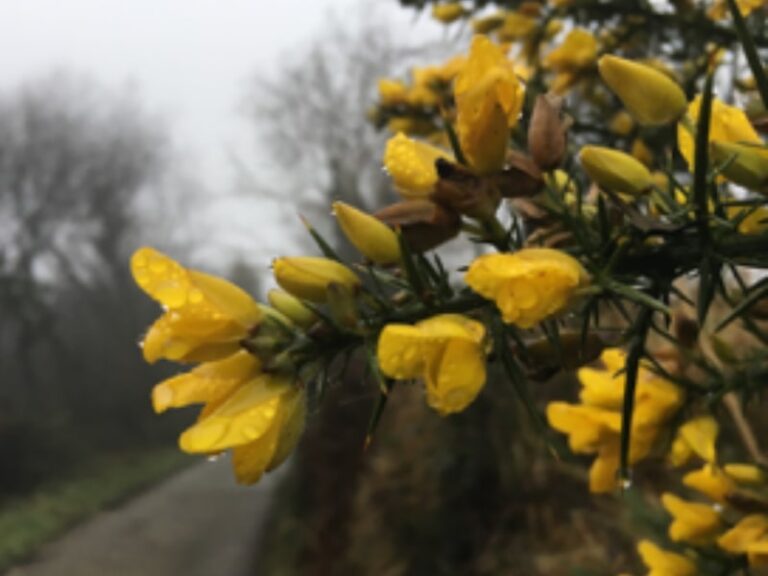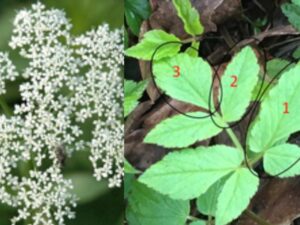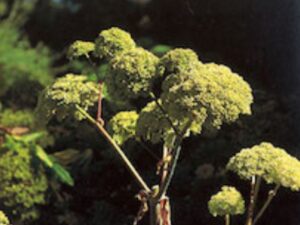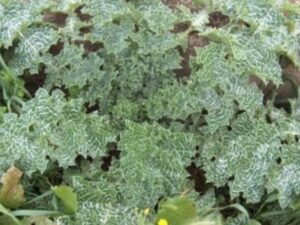Gorse – Ulex europeaus
Medicinally it has little value today. In the past, the seeds have been used to help rid the body of stones and to ease diarrhoea. They have also been found to contain a cardio-active alkaloid, Ulexine, which has been used in cardiac dropsy. The flowers were given in a tea to ease jaundice and scarlet fever. It also had a reputation for clearing people and livestock of worms.
Although its medicinal values are few, its past usefulness is unquestionable. The young shoots are edible and saved lives in the Irish famine. When burnt, the ash is an excellent fertiliser and can also be made into soap. It has been greatly prized in the past as a fuel, a dye, food for livestock, providing cover, stock-proof hedges and cleaning chimneys
The presence of Gorse, like that of thistles, is said to indicate rich soil. There is a saying referring to plants and the quality of soil –
Where there is Bracken there is GOLD;
Where there is Gorse there is SILVER;
Where there is Heather there is Poverty
Today I am very proud to present my guest blogger – John Handley – a good friend of Nadia’s so I will let her introduce him:
Thanks Jayne!
I first met John on an organised wildflower walk through Bridgnorth Cemetery. Since then he has helped me both artistically – for example he came round and helped me identify all the plants that were growing in a 2 metre quadrant of our lawn so that I could write a poem about each one for “Lawn Lore”; he has agreed to be recorded for, and written about Grey Squirrels – in Fair Acre Press’ project “Maligned Species”; but he has also helped enormously on a personal level, and is a very good friend. John knows an enormous amount about all aspects of nature, but his speciality are Grasses. He will soon have a website up and running – please ask for directions. He is also a keen forager.
Over to you John
And from John Handley,
The buttery, yellow flowers that crowd the spiny branches of Gorse plants are wonderful to see, as much because they can be flowering abundantly even in the middle of winter; there is a saying that “when gorse is in blossom, kissing’s in season”. This is as much about the three different species of gorse in Britain and the different times they flower through the year.
The picture of Gorse, Ulex europeaus, was taken on Dartmoor on the 7th January 2017.
The name ‘Gorse’ probably comes from the Anglo-Saxon word gorst, meaning ‘a waste’, referring to the plant growing in rough places. Another common name for it is ‘furze’, this is thought to have come from the Anglo-Saxon fyrs – Gorse has long been gathered for firewood. Oliver Rackham states that it is one of the very few fire-promoting plants of British woodlands (Rackham, 2006).
Gorse is one of the 151 species that make up the Fabaceae, pea family, within Britain. This family were formerly known as the Leguminosae, from which we get the phrase legumes. Many of the plants in this family have root nodules that contain symbiotic bacteria called Rhizobia. These bacteria can fix nitrogen from the atmosphere, where it is unavailable to plants, and convert it into a form the plant can use.
This adaptation means that gorse is a common plant of nutrient poor soils such as heathland and commons. As a pioneer plant it quickly colonises brownfield sites, and it is quick to establish itself on land that is reverting back from farmland.
My pleasure at seeing it bloom when so many other plants are in their basic form sets it apart, but for so many people, commoners, it was a daily blessing. It grows rapidly and requires no maintenance and provides a source of fuel that burns fiercely, an ideal source of kindling and perfect for the baker’s oven.
Its uses are varied, as much because the poverty which necessitated its collection provided the inspiration for its uses – therefore it has been used as a barrier to inhibit livestock, in the darkest of situations as a chimney brush, as a colourant for Easter eggs, scattered over the surface of seedbeds to discourage deer and pigeons, and bound up with heather to create a besom broom.
Gorse mills were used to bruise the gorse stems and help take the edge of the grooved spines; gorse was an important foodstuff for livestock, especially for horses, with an acre of gorse providing sufficient winter fodder for six horses. Its value meant that there were strict rules as to when it could be cut and how much each commoner could take. Richard Mabey (1998) refers to parishioners only being allowed to take as much as they could “carry on their backs”, on Cumnor Hurst, Oxfordshire following the Enclosure Award in 1820. In other areas of the country, rules prevented plants from being uprooted and only certain types of implements could be used, to restrict the amount that could be harvested.
The ability of gorse to flower over such an extended period and throughout an adverse period of the year makes it a useful plant for bees, who will use the pollen as they come out of hibernation. Bees are the primary pollinators of gorse: flowers that emerge in the winter produce as much pollen and are of comparable size to those produced in the spring. The winter flowers stay open for longer and the particular appeal of winter flowers means that the pollination is as high in the winter as the spring.
My main use for gorse is as a tea.
You can use the flowers fresh or dried: a useful tip is to pick the flowers and put them to one side until they have wilted a little, any residents will leave and you won’t have to fish them out of your cup! It is said to smell and taste of coconuts though that defeats many of the people I mention it to. A dozen flowers per person if using fresh flowers, half a dozen if using dried flowers, bruise them to bring out the flavour and infuse in boiling water. I serve it with a little lime flower honey, a lovely buttery taste that I find soothing for throats too.
John
MABEY, R. (1998) Flora Britannica, Chatto and Windus, London.
RACKHAM, O. (2006). Woodlands (New Naturalist). Harper Collins, London.
And finally
Here is a poem from Nadia Kingsley:
Striking it rich
When you see the golden flowers
know that gorse is as common as kisses
that it talks with stonechats
its blossom smells of coconuts
its buds – seams of protein.
I read of a drunk
who woke
ten foot in
took a helicopter
to free him.
It’s not an easy harvest:
be armed with a basket
leather on hand
some vinegar, some bandages
a prayer on your tongue.




